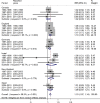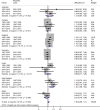Gender differences in measles incidence rates in a multi-year, pooled analysis, based on national data from seven high income countries
- PMID: 35410143
- PMCID: PMC8996552
- DOI: 10.1186/s12879-022-07340-3
Gender differences in measles incidence rates in a multi-year, pooled analysis, based on national data from seven high income countries
Abstract
Background: Gender differences in a number of infectious diseases have been reported. The evidence for gender differences in clinical measles incidence rates has been variable and poorly documented over age groups, countries and time periods.
Methods: We obtained data on cases of measles by sex and age group over a period of 11-27 years from seven countries. Male to female incidence rate ratios (IRR) were computed for each year, by country and age group. For each age group, we used meta-analytic methods to combine the IRRs. Meta-regression was conducted to the estimate the effects of age, country, and time period on the IRR.
Results: In the age groups < 1, 1-4, 5-9, 10-14, 15-44, and 45-64 the pooled IRRs (with 95% CI) were 1.07 (1.02-1.11), 1.10 (1.07-1.14), 1.03 (1.00-1.05), 1.05 (0.99-1.11), 1.08 (0.95-1.23), and 0.82 (0.74-0.92) respectively. The excess incidence rates (IR) from measles in males up to age 45 are remarkably consistent across countries and time-periods. In the age group 45-64, there is an excess incidence in women.
Conclusions: The consistency of the excess incidence rates in young males suggest that the sex differences are more likely due to physiological and biological differences and not behavioral factors. At older ages, differential exposure can play a part. These findings can provide further keys to the understanding of mechanisms of infection and tailoring vaccination schedules.
Keywords: Incidence rate ratios; Measles; Meta-analysis; Sex differences.
© 2022. The Author(s).
Conflict of interest statement
The authors declare that they have no competing interests.
Figures






Similar articles
-
Sex differences in hepatitis A incidence rates-a multi-year pooled-analysis based on national data from nine high-income countries.PLoS One. 2023 Jun 13;18(6):e0287008. doi: 10.1371/journal.pone.0287008. eCollection 2023. PLoS One. 2023. PMID: 37310964 Free PMC article.
-
Gender differences in tuberculosis incidence rates-A pooled analysis of data from seven high-income countries by age group and time period.Front Public Health. 2023 Jan 10;10:997025. doi: 10.3389/fpubh.2022.997025. eCollection 2022. Front Public Health. 2023. PMID: 36703824 Free PMC article.
-
Sex differences in campylobacteriosis incidence rates at different ages - a seven country, multi-year, meta-analysis. A potential mechanism for the infection.BMC Infect Dis. 2020 Aug 25;20(1):625. doi: 10.1186/s12879-020-05351-6. BMC Infect Dis. 2020. PMID: 32842973 Free PMC article.
-
[Measles control in developing countries].Sante. 1994 May-Jun;4(3):163-71. Sante. 1994. PMID: 7921681 Review. French.
-
Prospects for the eradication of infectious diseases.Rev Infect Dis. 1984 May-Jun;6(3):405-11. doi: 10.1093/clinids/6.3.405. Rev Infect Dis. 1984. PMID: 6377445 Review.
Cited by
-
Immune Cells, Gut Microbiota, and Vaccines: A Gender Perspective.Cells. 2024 Mar 17;13(6):526. doi: 10.3390/cells13060526. Cells. 2024. PMID: 38534370 Free PMC article. Review.
-
Low Measles Seropositivity in Vaccinated Children.JAMA Netw Open. 2025 Aug 1;8(8):e2529409. doi: 10.1001/jamanetworkopen.2025.29409. JAMA Netw Open. 2025. PMID: 40864465 Free PMC article.
-
Impact of measles vaccination on clinical characteristics and outcomes in children in Ramadi, Iraq.World J Clin Pediatr. 2025 Sep 9;14(3):107253. doi: 10.5409/wjcp.v14.i3.107253. eCollection 2025 Sep 9. World J Clin Pediatr. 2025. PMID: 40881081
-
Attention to COVID 19 pandemic resulted in increased measles cases and deaths in Zambia.Trop Med Health. 2025 Apr 25;53(1):59. doi: 10.1186/s41182-025-00736-2. Trop Med Health. 2025. PMID: 40281501 Free PMC article.
-
Low Rates of Immunity among Medical Students and Residents in the Era of the Resurgence of Measles.Pathogens. 2024 Sep 11;13(9):784. doi: 10.3390/pathogens13090784. Pathogens. 2024. PMID: 39338975 Free PMC article.
References
MeSH terms
LinkOut - more resources
Full Text Sources
Medical

